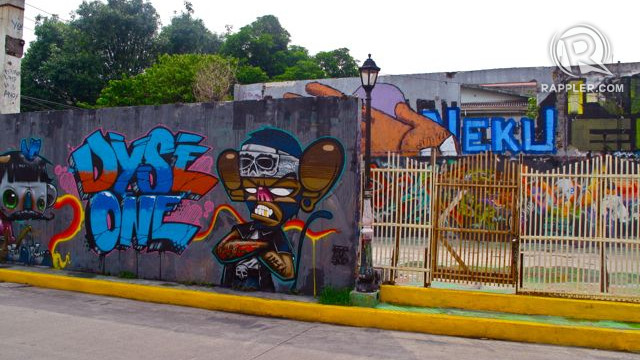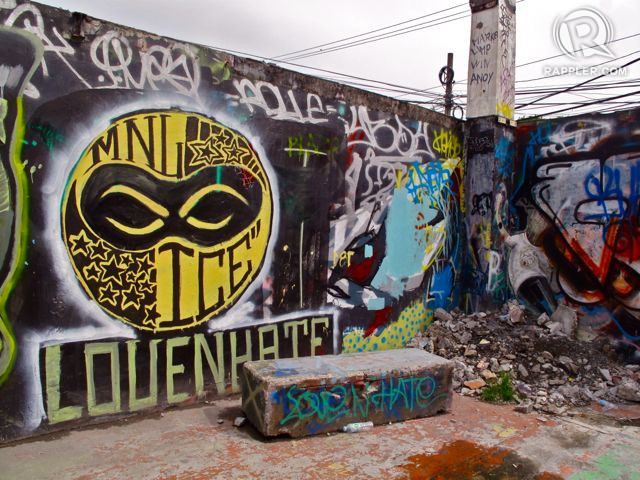SUMMARY
This is AI generated summarization, which may have errors. For context, always refer to the full article.

MANILA, Philippines – The phrase “street art” may be synonymous with the word “graffiti” yet the two have vastly different connotations.
One is a glorified form of expression, highly applauded by pedestrian and web audiences and often called a representation of the true artistic consciousness of the masses. The other is intrinsically related to vandalism, and to crime.
This verbal paradox captures our flawed preconceptions of what it means to be a graffiti artist. With the graffiti culture on the rise in the Philippines in the past couple of years, I ask, how does this dichotomy translate to Manila’s streets?
Tucked away into a pocket of Intramuros is an empty lot with a not-so-empty façade. When I visited, the walls on the left bank were covered in work of different colors, styles, and artistic signatures.
The work, and respective tags, of different local street artists intermingled on the concrete. Some of the pieces overlapped each other, showing the organic nature of these walls; the art constantly changes as artists paint wherever they find space, even if that space is on top of an existing piece. The artists build on, and off of, each other’s work to create a giant and ever-changing canvas.

The wall on the right bank of the lot is covered with a fresh coat of white. You can see faint outlines of the covered graffiti and, on this white coat, the possibility of all the new art that would soon cover it.
This lot, located at the CBCP building in the walled city, challenges our preconceptions of “graffiti.” It was handed over by the Intramuros administration to the artist collective Pilipinas Street Plan (PSP) in 2007 as both parties saw the lot’s potential to bring contemporary art to the historic area.
The result? One of the first legal graffiti walls in the Philippines.
Vandalism vs art
According to artist Darko, who often works in this space himself, the wall changed “easily, due to the fast growing street art community in the Philippines. The Intramuros spot became famous and the whole place got covered within weeks.”
Since the legalization of graffiti here, “The graffiti scene [has] boomed,” he says. “That was a turning point where street art and graffiti [began to get] noticed.”

The legalitzation of graffiti is a very familiar debate, one in which graffiti artists themselves seem to be split. When asked in an interview with “Artes de las Filipinas” whether or not he considered graffiti to be vandalism, the street artist Hepe replied: “All acts of private and public destruction and distraction are forms of vandalism. Destruction through construction is a different story.”
Surely, there is some truth to his words. World famous street artist Banksy is a prime example of this; should Banksy “vandalize” a wall on a property, the value of that property can reportedly rise from US$75,000 to US$200,000.
Banksy’s works add a new dimension to these buildings that even real estate markets appreciate – why can’t the same be said of the works of local artists like Hepe or Darko?
Darko, on the other hand, thinks that graffiti will never be completely legal, and never should be.
“I myself don’t want graffiti to be legal. I’m a vandal. Not an artist.” He sees legalization as too big of a game changer – in a bad way.
“There’s a big difference in running from the cops and putting yourself in heights just to throw up your mark.” This, for Darko, is where the real thrill of the art lies.
For different members of the local graffiti scene, legalization of their art strikes different chords. So how has the legalization of an art form so defined by illegality affected the art culture?
“Legalization of any wall brings in a lot of texture, technique and even color and style,” says Darko.
“Hand in hand with a legal wall is progress, since you can take your time in doing a piece or practice over and over again without any hassle with the authorities.”

Legalization of street art here in Intramuros, it seems, has resulted in a growth of the art form and even the introduction of new young artists to the scene.
Graffiti art has boomed, signifying a paradigm shift not just in the way that people receive graffiti but in the way that graffiti artists themselves view their work and its possibilities.
Nowadays, says Darko, graffiti is “getting more and more accepted even in the corporate businesses.”
This Intramuros lot is only one example of the many legal walls around the country. Wherever a building-owner commissions or allows graffiti, a legal wall and in effect a legal urban canvas pops up.
The legalization has allowed artists to expand their styles and techniques without threat of incarceration. For Darko, however, the essence of graffiti art will always be the same. In the words of this self-proclaimed “vandal,” “The real game is on the streets, not on the legal walls.” – Rappler.com
You can find Darko on Facebook under the name Darko Manila.
Add a comment
How does this make you feel?
There are no comments yet. Add your comment to start the conversation.